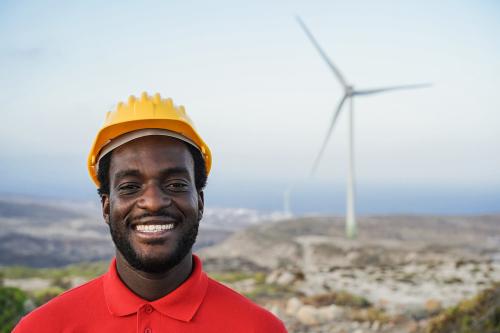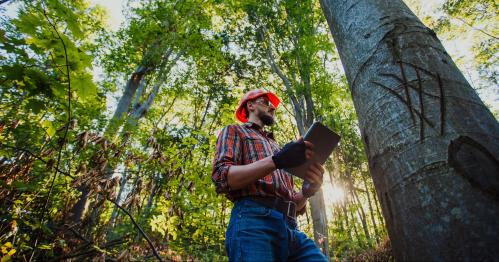Labor Day began in 1894 as a day to celebrate the contributions of workers and local labor unions. Now, in a world increasingly disrupted by climate change as well as massive technological change, it’s also a moment to grapple with the future of work.
For millions of American workers—and voters—that future is far from assured. They have heard our leaders tout clean energy and the rebuilding of our aging infrastructure as pathways to opportunity and a secure place in the middle class, but find that those pathways are barely open—and for many, not even in sight. That’s in spite of record-low unemployment, worker shortages that are impeding delivery of major projects across the country, and brisk hiring in the construction trades—such as electricians, carpenters, and pipefitters—and support occupations, from coders to haulers.
We’re at the beginning of a build-and-make decade. But the scale of what we’re hoping to construct and manufacture—relative to what the country has committed to preparing and fairly rewarding our workers—is astonishing. The most critical commitments need to come from state and local governments, because they decide most energy, water, transportation, and other infrastructure projects, and articulate most of the expectations for engineering and building firms and other private employers, whose commitment is also essential. That’s true even when it’s federal funding, which is now at levels not seen in half a century, and even though a clear national framework is also needed, as highlighted in recent research on these sectors (and manufacturing as well).
Other advanced economies approach these choices very differently, in ways that make a profound difference for workers and employers. Ask someone in Europe or Japan how to get a job with middle-class wages without a college degree, and the answers are relatively straightforward. Government, business, and organized labor work together to track demand for particular types of skills and to ensure that almost anyone can get the support they need to get the right high-quality training and certification tied to good wages, often through earn-while-you-learn apprenticeships. Workers also get the protections afforded by labor agreements and effective public monitoring of work sites. There’s a well-documented and often quite rapid return on investment to this arrangement: It pays off for employers, government, and the economy as a whole, not just for workers, thanks to higher productivity and tax revenues.
But here in America, where we will need to recruit and prepare an estimated 32 million new workers just in infrastructure and other construction-related occupations over the next decade (the equivalent of the population of Texas), we combine a choose-your-own-adventure approach to much of our workforce development with a narrowly siloed approach to infrastructure funding. The two sides of the equation—project funders and employers on one side, training providers on the other—don’t coordinate nearly enough. The result? As new job growth booms, the sector is also struggling mightily to retain the workers it has.
According to Brookings Institution research, 17 million workers are likely to permanently leave the infrastructure workforce over the next decade, mostly to retirement or other kinds of work. Along with refilling their slots, 15 million additional workers are needed to handle growth. But many prospective workers—especially people of color, women, and others long discouraged and excluded from many of these jobs—don’t yet view these careers as good prospects for them, or may not even know they exist. And they lack flexible ways to enter and grow in them, including on-the-job training, credentialing, and supportive services such as affordable and accessible child care.
Underlying that, governors, lawmakers, advocates, and the media usually treat infrastructure agencies as though ensuring an excellent and inclusive workforce is someone else’s job: Just focus on the capital projects, and assume a skilled workforce will materialize. Leaders in education, training, and labor need to be engaged, of course, along with community voices. But they can’t do this lift alone—not without those who will sponsor trillions of dollars in capital projects and hire the workers to produce them. For one, our system of applied training just doesn’t have the money. If it were on par with other advanced economies, there would be millions of funded apprenticeships and pre-apprenticeships available in America each year, not the approximately 600,000 reported in Labor Department data.
We’ve been on this path for a while. After the 1970s, as we sought to expand college access regardless of race and as “vocational education” acquired a negative stigma, the U.S. scaled back earn-while-you-learn and other applied programs. Though funding and bipartisan political support for apprenticeships have shown encouraging growth in recent years, it’s still miniscule overall: In per capita terms, we spend about one-tenth what the United Kingdom or Switzerland spend—and, shockingly, about one-fiftieth what we spend subsidizing college education.
In the context of a shrinking, aging, and nondiverse, mostly white male skilled trades workforce, America needs more workers and more inclusion—drawing in younger people, women, people of color, and others facing barriers—to fill these careers and make it possible for us to achieve big national goals. According to recent analyses, only 11% of infrastructure workers are under the age of 24, and only 19% are women. People of color are also dramatically under-represented in a range of occupations relative to the labor market as a whole. This is in spite of the opportunity these careers present: Infrastructure jobs tend to require less formal education (54% of infrastructure workers have a high school degree or less), and lower-income workers can earn 30% higher pay relative to other jobs nationally. Workers of color, especially Black and Hispanic workers, also tend to be concentrated in lower-wage occupations in the sector: They make up 44% of the nation’s laborers and material movers, for example, whose average salary is about $35,000 per year, but only 23% of electricians, who earn an average of $63,000 per year.
Thankfully, our leaders are starting to recognize that smart and well-funded approaches are a must. Take Pennsylvania’s first-of-its-kind Commonwealth Workforce Transformation Program, announced weeks ago by Governor Josh Shapiro at the steamfitters union hall in Philadelphia. It is the largest and boldest commitment by a state thus far to set aside a portion of the massive federal capital funds provided by the Infrastructure Investment and Jobs Act of 2021 and the Inflation Reduction Act of 2022 to ensure well-prepared and fairly rewarded workers. The governor has used an executive order to set aside at least 3% of the state’s expected allocation, or as much as $400 million. To put the scale in perspective: That small share of the state’s capital plan for infrastructure is the largest single workforce investment of any kind in the state’s history.
We need many more states to follow Pennsylvania’s example—leading with resources and high standards, as recent analysis has outlined, engaging community colleges, and complementing the important contributions that union training programs make (an estimated $2 billion per year from the building trades alone).
The local, tribal, and special purpose agencies closest to the projects, such as the Port of Los Angeles-Long Beach, are likewise beginning to commit vital funding to ensure workforce training and good-paying jobs. In addition to funding, the Port, which handles about 40% of all the goods entering our country, has a comprehensive local hire policy in place to make sure the surrounding community benefits from major investments to expand and modernize. A range of strategies like these—permitted but not required in the major federal investment laws—can be tailored to local needs.
Likewise, private philanthropy—which has a long history of investing in education and training innovation, plus a more recent history of supporting worker advocacy and job-quality initiatives—is beginning to lean into the big climate and infrastructure opportunity. A major focus is supporting and documenting innovations that can be scaled up, but only if there’s adequate funding and coordination across philanthropy and the public and private sectors. Through the Families and Workers Fund, for example, more than 40 donors have pooled and coordinated their resources to invest in organizations such as PowerCorpsPHL, which is providing inclusive training for green jobs, and Better Builder, which is improving job quality and worker economic mobility in construction. These are demonstration, reform, and leadership efforts—not acts of charity meant to compensate for dramatically underfunded, unproductive, and unfair systems that confront opportunity seekers with one barrier after another. And that’s how it should be for philanthropy seeking a transformative impact.
What motivates this big tent of players? The basic principle that we shouldn’t return to the pre-pandemic “normal”—not when it comes to work and the workforce, because normal wasn’t close to good enough. The reality is that we cannot build the infrastructure of the future, including clean energy and other vital pillars of a new economy, without the workforce of the future. It’s time to embrace what an economy for all, one that builds and makes amazing things, will actually require.






Commentary
We haven’t yet decided that climate and infrastructure jobs are for everyone, or even that we’ll have enough workers
September 1, 2023